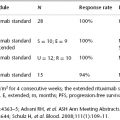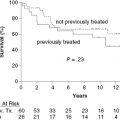Case study 69.1 A 55-year-old patient who received an allogeneic hematopoietic cell transplant (HCT) for high-risk myelodysplastic syndrome (MDS) has returned closer to home after his day 100 post-HCT evaluation, and plans to have his routine follow-up visits in your clinic.
1. Which of the following would increase his chance of developing cGVHD?
Human leukocyte antigen (HLA) mismatch between donor and recipient History of prior acute graft-versus-host disease (GVHD) Use of peripheral blood stem cells as graft source Use of a female donor into a male recipient Older patient age All of the above Known risk factors for the development of cGVHD include prior acute GVHD, use of peripheral blood stem cells as a grafting source, use of a female donor for a male recipient, older patient age, and use of an HLA-mismatched and/or unrelated donor. Flowers et al . (2011) retrospectively analyzed 2941 adult and pediatric HCT recipients in order to confirm these previously reported risk factors. These investigators reported a 34% cumulative incidence of cGVHD at 2 years post-HCT with a median time to onset of 162 days post-HCT. Anasetti et al . (2012) recently reported that recipients of peripheral blood stem cell grafts experienced a significantly increased incidence of cGVHD when compared to bone marrow recipients (53% vs. 41%; P = 0.01).
The patient received an 8 out of 8 HLA-matched unrelated donor transplant from a female donor following a reduced-intensity conditioning regimen. He developed biopsy-proven mild skin acute GVHD at day 45 posttransplant that resolved following treatment with topical therapy alone. His tacrolimus taper was started at day 90, with a plan to taper monthly until discontinuation around day 180.
2. What are some of the diagnostic features of cGVHD for which the patient should be monitored during your subsequent follow-up visits to guide your decision to continue the tacrolimus taper?
Oral mucosal changes, including lichenoid markings and hyperkeratotic plaques Skin changes, including poikiloderma, lichen planus–like features, lichen sclerosis–like features, sclerotic features, and morphea-like features Joint stiffness or contractions secondary to sclerosis A and B are correct. All of the above The median time to cGVHD diagnosis is approximately 6 months post-HCT, and new-onset cGVHD is rarely diagnosed beyond one year. Disease manifestations can be highly variable, and almost every organ system can be involved. The NIH Consensus Development Project on Criteria for Clinical Trials in Chronic Graft-versus-Host Disease published a series of articles that aimed to standardize the diagnosis, classification, and response criteria for cGVHD. This system replaced the “limited” versus “extensive” classification system first described in 1980.
Filipovich et al . (2005) proposed an extensive list of diagnostic features (sufficient to establish the diagnosis of cGVHD), distinctive features (present in cGVHD, but insufficient alone to establish the diagnosis), other features (known to be associated with cGVHD, but not frequent enough to be diagnostic or distinct), and common features (seen in both acute and chronic GVHD) seen in the eight commonly affected organs (see Table 69.1 ). A photo atlas of diagnostic features is included (Figures 69.1 , 69.2 , and 69.3 ). The presence of any of the diagnostic manifestations of cGVHD can establish the diagnosis without a confirmatory biopsy, while the diagnosis of cGVHD cannot be established without additional confirmatory testing when only distinctive features are present.
Table 69.1
Figure 69.1 Figure 69.2 Figure 69.3 The patient is evaluated in your office on day 120. He has no signs of GVHD, so you taper his tacrolimus. He returns for follow-up on day 150 and presents with new symptoms that are concerning for GVHD.
3. Match the symptoms with the correct classification of late acute GVHD, classic cGVHD, or overlap syndrome.
< div class='tao-gold-member'>






